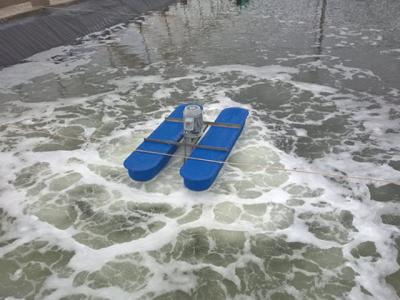Aeration - A Wastewater Treatment Process

Wastewater lagoon aeration represents one of the most energy intensive operations in the wastewater treatment system, consuming between 50 and 90% of the total energy costs of a typical municipal treatment facility. A general data survey made available about 20 years ago on municipal and industrial wastewater treatment installations show that there are approximately 1.3 million kw of aeration equipment in place at an installation value of between $0.6 and 0.8 billion dollars. Operating costs estimated in 1982 were to be about 0.6 billion per year.
The testing of oxygen transfer devices in both clean and process waters is a recent major change that has taken place in this field. Extensive aeration equipment tests in process waters using new, more accurate techniques have led to a better understanding of the translation of clean water tests results to process conditions. Diffused aeration is defined as the injection of gas ( air or oxygen ) under pressure below the liquid surface. The interest in fine bubble aeration has instigated new equipment development and a multiplicity of new maintenance considerations. Field studies have demonstrated the importance of diffusers placement and tank geometry have produced more efficient system designs sewage treatment
Experiments on wastewater aeration started in England as early as 1882. They continued on aeration and aerated filter wastewater treatment in England and the U.S. until the activated sludge process was unleashed to the world in April of 1914.
In the early experiments, air was introduced through open tubes or perforations. As the activated sludge process investigation progressed, greater economy was sought with smaller bubbles produced by porous media. In 1914, experiments were made with natural limestone, fire brick, sand and glass mixtures, pumice and other materials. They were all found to be to dense. In 1915 a porous plate set in a cast iron box was developed. In the following years, experiments with porous media and other media continued.
Diffuser clogging was a problem in numerous cases from the earliest aeration experiments. Around 1915, perforated pipes were abandoned in favor of diffusers because 90% of the jets had plugged. With the advent of porous diffusers, clogging became an even greater problem. Early work between 1922 to 1924 prompted coarser media use to avoid severe clogging problems.
Mechanical aeration was one answer to the clogging problem. Down draft and up draft type mechanical aerators were developed to diffuse air efficiently and to solve clogging problems.
Another approach to the clogging problem was the development of the large orifice-type diffuser. First developed in the 1950's, these units improved on earlier perforated pipes and were designer for easy maintenance and accessibility. These devices generated larger bubbles and sacrificed substantial transfer efficiency for maintenance ease.
With the emphasis on more energy efficient aeration systems in the 1970's, the technology turned to fine bubble systems. Emphasis on fine pore diffusion has lead to many extensive research programs aimed at the evaluation of design, operation, and control processes relative to improving overall system performance.
Related news
 Use of Copper in Freshwater Aquaculture and Farm Ponds
Use of Copper in Freshwater Aquaculture and Farm Ponds Copper has been used for many years as a chemical tool in freshwater farm ponds and aquaculture operations. It is both an effective algicide
 Ecosystem-based climate change adaptation reaps fruits
Ecosystem-based climate change adaptation reaps fruits An ecosystem-based climate change adaptation project sponsored by the German Federal Ministry of Environment, Nature Conservation and Building & Nuclear Safety
 O2-Turbine Aerator enables oxygen enrichment with better energy efficiency
O2-Turbine Aerator enables oxygen enrichment with better energy efficiency Fish farming requires dissolved oxygen and fish food in order to increase fish crop. Enriching dissolved oxygen in fishponds is achieved through aerator devices